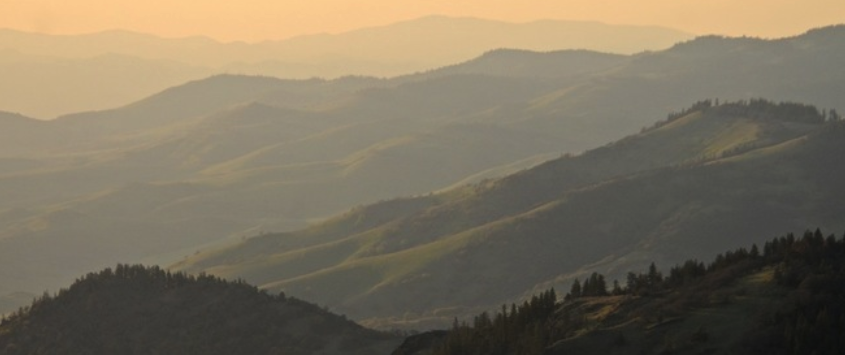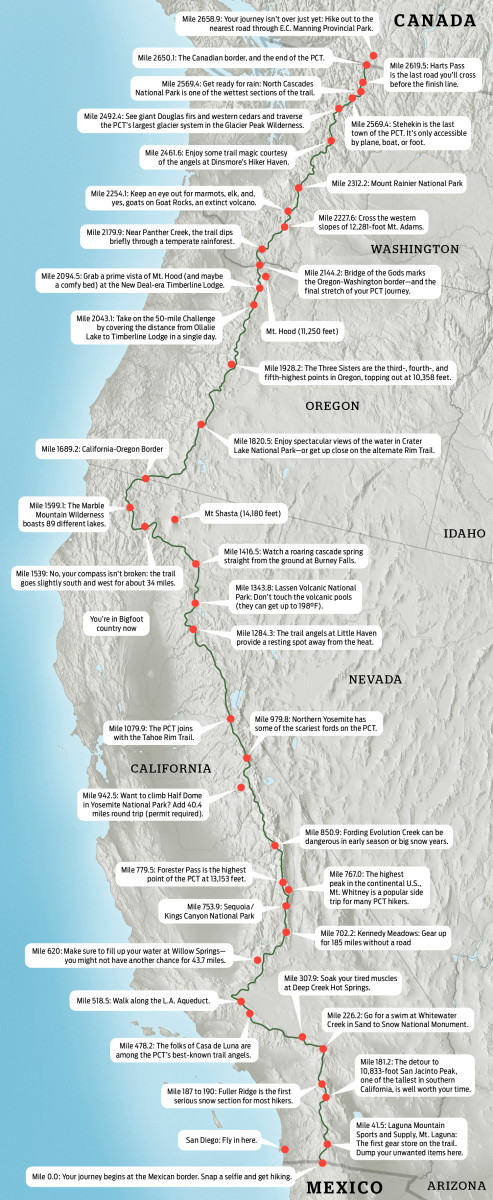
Hiking the terrain in Southern Oregon. [o]
5. I crave endless floating in the crystal, cold water to capture and hold the fading summer. But my husband has already gotten out and we have three more miles ahead of us on this eleven-mile hike. I dog paddle toward shore, relishing the freedom of swimming naked in pure mountain waters. I walk chilly hands along the bottom, body floating behind, so I can avoid much of the slippery sludge on my feet. When thighs scrape bottom, I lift my heavy-feeling body, cool and refreshed, and tread to the shore where sweaty clothes and my husband are drying in the warm sun. I long for summer to never end and want to breathe in this spectacular scene and embrace it forever — in gratitude.
I know from experience, once I’m all the way in it will be heaven. But I cringe at the transition.
4. When we get to the edge of the lake, we strip down. I shuffle into toe-numbing water. Inch by inch, I push myself deeper, careful that my feet don’t slip on the slimy, rocky bottom. I know from experience, once I’m all the way in it will be heaven. But I cringe at the transition. The water touches my abdomen and I stiffen. Can I do it? A one-two-three-go? No, I shrink. Try again. A one-two-three… No again. This time I lean forward so I can’t chicken out. One-two-three . . . splash and in! Frantic movement, a blast of unbelievable cold, and then I relax in sparkling ecstasy.
3. After a mile and a half on an unmarked trail, we arrive at the Pacific Crest Trail. We will hike in a loop today, heading north on the PCT for three miles and back on another trail that takes us past several mountain lakes. We stop along the way to suck into our mouths tangy sweet huckleberries that dot both sides of the trail. Veering off on the loop trail, I feel powerful and proud as our 60-something legs take us deep into nature. The late-summer lakes lie low from drought, with yards of grasses along the shore that keep us from getting close. We sit on a log to view Red Lake with mountains rising behind and munch on sandwiches of oat bread and smoked turkey. Mexican-style chocolate delights our taste buds for dessert. Back on the trail, we come upon an unmarked lake with no grasses. It begs us to swim.

One of the great hiking paths, the Pacific Crest Trail. [o]
2. My phone alarm plays a soft Tango to Evora at 5:00 am. I pop out of bed, excited for the coming adventure. We pack up our gear, make lunch, add snacks, eat oatmeal, and make Pu-er tea from the Yunnan Province, adding local honey for our thermoses. We drive our Subaru along mountain roads, from pavement to gravel to the turn-off on a side road we’ve studied on maps, hoping to drive unobstructed to an unnamed trail that will take us to the PCT. The road is clear of fallen trees and debris. At 7:45 a.m., we raise our hands for a high five as we step onto the trail. Our persistent study of maps has paid off. The cool morning welcomes us as sunlight dapples the forest floor and begins to light up Ponderosa Pines and Douglas Firs. I breathe in, delighted to be once again on a hiking adventure.
1. My husband and I share a passion for hiking — one of the things that sparked our attraction nearly seven years ago. What we didn’t know then is that hiking would keep us sane during the coronavirus pandemic and political upheaval — the slippery sludge of 2020. We shed our disappointments from cancelled travel plans by trekking in early spring mud and crusty snow leftovers to Hobart Bluff for a view of Mt. Shasta to the south and the Rogue Valley, our home, to the north. Our spirits are soaring! Hence we hatch a plan to day-hike the entire Pacific Crest Trail from the California border to Crater Lake over the coming hiking season. In the evenings, we huddle at the computer, studying maps on Gaia GPS. Each week, nature greets us with tall, silent forests, fields of flamboyant wildflowers, new angles of our local mountains, and rocky overlooks where we scramble to catch stunning views. We sink into appreciating the land with every step. Earth’s bounty gifts us with wild mushrooms and resilient hearts. By late August, we have completed all sections of the PCT except for the Sky Lakes Wilderness, where ravenous mosquitos crowd the air until late summer. The PCT here is difficult to access for day hiking because it follows the ridge in the center of the Wilderness Area. But we’ve been studying all summer, creating routes, making plans. It’s kept us busy and engaged, even as our moods have bounced around in these trying times. At night our dreams merge with the expansive splendor of this sacred earth we have caressed with each boot print. ≈ç

Julie Lockhart fills out
The Wild Culture Scribbler's Questionnaire
What is your first memory and what does it tell you about your life at that time and your life at this time?
My grandmother gave me a Kewpie doll when I was a baby. I loved “Effie May” and carried her everywhere, but lost her when I was about 4. My parents looked everywhere, even the Chinese laundry where my father had his dress shirts cleaned. Dad finally found her in the nearby park by a tree, stripped of her little yellow dress. The story my Dad told was that some kids must have used her as a football. This experience imprinted in me that persistence pays off—with a little dash of good luck. I like to keep this in mind as a writer with a number of rejection letters!
Can you name a handful of artists in your field, or any fields, who have influenced you — who comes to mind immediately?
My mother and grandmother were both painters, so I got to watch each of them fuss with every brush stroke and image until they got it right. And then they’d work at it a bit more…and more. Writing is like that, too. I can always make it better.
Where did you grow up, and did that place and your experience of it help form your sense about place and the environment in general?
I grew up in the suburbs of Chicago. I remember gazing out the window at houses up and down the street, wondering what it would be like to live amongst trees with no other houses around me. My father loved the mountains, so our family vacations triggered my love for wild places. I took advantage of an opportunity to move west after college!
If you were going away on a very long journey and could only take four books — one poetry, one fiction, one nonfiction, and one literary criticism — what would they be?
My favorite poetry book is Dream Work, by Mary Oliver (the poem “The Journey” is a lifelong favorite). For fiction, Winter’s Tale by Mark Helprin. Such a magical story! For nonfiction, Resurrecting Jesus by Adyashanti, for its mystical perspective on the life of Jesus. I’d leave the literary criticism books at home to save space for my favorite Taza Mexican chocolate.
What was your most keen interest between the ages of 10 and 12?
When I was 10, our family took a vacation to Oregon where I delighted in so many experiences — a snowball fight in summer on Mt. Hood, the waves crashing around Haystack Rock at Cannon Beach, the intense blue of Crater Lake, and the shocking cold as I dove into the Lewis River in Southwest Washington. That trip sparked my love of the west and the adventures it promised that lasted well beyond my 12th birthday.
At what point did you discover your ability with nature writing?
In 2006, I signed up for a creative nonfiction course where I wrote an essay about a kayak trip and a wind storm that almost flipped my boat. The teacher didn’t like my story, for reasons I can’t remember. I’ve been working at the craft of CNF ever since.
Do you have an “engine” that drives your artistic practice, and if so, can you comment on it?
If by “engine” you mean motivation, I thrive on deadlines to get me going, such as contests. Otherwise I am part of a weekly writing group with three other memoir-style writers. We do timed writings, sometimes using prompts, other times writing about things going on in our lives. And if I need a further kick in the rear, I’ll sign up for an online writing course.
If you were to meet a person who seriously wants to do work in your field — someone who admires and resonates with the type of work you do, and they clearly have real talent — and they ask you for some general advice, what would that be?
I have had two tracks in my career — first in academics and then in nonprofit work. Both helped me hone my writing skills. One of the best lessons in the “publish or perish” academic track is that publication acceptance is so subjective. Even really good work can be rejected. I learned not to take it personally. So if I met a good writer, this would be my first piece of advice: rejection is not personal. Keep on working at it. My second recommendation is to make sure you can support yourself — especially for women — even if it’s a job outside of the writing field. Financial independence was a great gift I gave myself.
Do you have a current question or preoccupation you could share with us?
I have accumulated a large collection of essays in various stages of completion. I ponder what to do with them all. Fortunately, it doesn’t take up space in my house like all of the paintings my mother and grandmother accomplished that never sold. Still, it’s a “what’s the point” preoccupation. I am considering a blog or a book of essays.
What does the term “wild culture” mean to you?
I’d love to be part of a group discussion on the meaning of wild culture. I see the culture in the U.S. as potentially crumbling. Yet what is beautiful will hopefully remain — our National Parks, forests, monuments, wilderness areas. Wild places are a balm to the toxicity. Wild culture represents those places in which I can remember awe in the midst of the craziness of humanity.
If you would like to ask yourself a final question, what would it be?
In what ways does your writing encourage personal growth? I’m a big fan of timed writing—by hand, on paper. I started doing this with a friend in 2010. Over the course of several years, we laughed, we cried, we got clarity on our life challenges. I still set a timer and write by hand when I’m stuck in a writing project. My writing has gotten better, along with my emotional health.

JULIE LOCKHART loves an adventure, especially in wild places. She spent most of her career in academics, where she published extensively in peer-reviewed journals, such as Critical Issues in Environmental Taxation; and Advances in Accounting Education. During the last years of her career, she led a grief support nonprofit organization. Julie recently moved to Port Townsend, Washington.

Add new comment